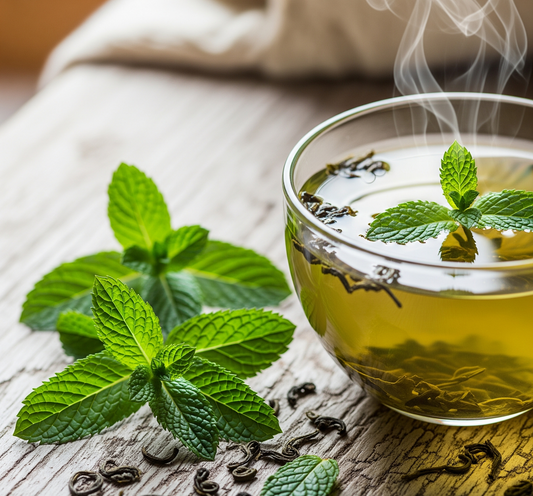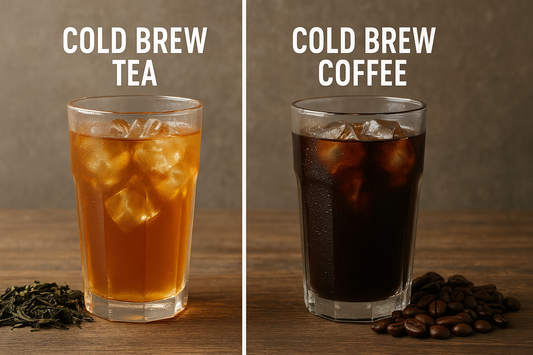A glass tea infuser is a must-have for tea enthusiasts, allowing you to steep loose-leaf tea and enjoy a richer, more aromatic brew. Unlike tea bags, it provides ample space for leaves to expand. Glass infusers are elegant, reusable, and versatile, suitable for brewing various tea types hot or cold. With proper use and care, a glass tea infuser can elevate your tea experience to new heights.
As a tea enthusiast, you’ve most likely come across the term “tea infuser”; and if you haven't yet, you’re bound to come across it sooner rather than later. Using a tea infuser can transform your tea-drinking experience from normal to extraordinary.
If you’re looking to get into the aromatic world of loose-leaf tea, a glass tea infuser is an excellent choice. This amazing tool is not just functional; it’s also a great addition to your kitchen. In this blog, we’ll explore everything you need to know about using a glass tea infuser, including how it works, how you can brew loose-leaf tea with it, and tips on how you can get the most out of your tea infuser.
Let’s start with the basics:
What is a Tea Infuser Used For?
A tea infuser serves as a handy tool that allows you to steep loose-leaf tea leaves without letting them fall into your cup. You might wonder, “Why not just use tea bags since they do the same thing?” Unlike tea bags, a loose-leaf tea infuser provides the leaves with ample space to fully expand, enhancing the flavor and aroma of your brew. This results in a much richer and more aromatic cup of tea. Many tea infuser bottles feature built-in or detachable strainers that filter out the tea leaves as you pour your tea into a cup, ensuring a smooth drinking experience.

Tea infusers typically exceed the size of most cups and mugs. So, you can find infuser bottles ranging from 270 ml to 800 ml or even more, allowing you to brew larger quantities of tea for extended enjoyment. Additionally, these infuser bottles often come with lids that help keep your tea fresh for longer, making them an excellent choice for tea enthusiasts.
How Does a Glass Tea Infuser Work?
To put it simply, a glass tea infuser operates on a simple principle: it allows hot water to flow through the loose tea leaves, extracting their flavor and nutrients. Here’s how it works:
- Fill the Infuser: Place the desired quantity of your loose tea leaves inside the infuser. You should ideally use around one teaspoon of loose-leaf tea per six ounces of water. However, you can put more or less based on your preference.
- Add Hot or Room Temperature Water: Pour hot water over the tea leaves. The water temperature will depend on the type of tea you’re using. For example, green teas typically require cooler water (around 160°F), while black teas thrive in boiling water (around 210°F). You can also pour room-temperature water into the bottle if you plan to craft a bottle of cold-brew tea.
- Steep: Allow the tea to steep for the recommended time. Most teas need about 3 to 5 minutes, but you can adjust this based on your taste preference. If you’re making cold brew tea, it is recommended to let the tea leaves steep for 3 to 6 hours or overnight in the fridge.
- Pour the Infused Tea and Enjoy: Once steeped, pour the delicious beverage into a cup or mug and enjoy a serving of delicious or cold brewed tea. Given you’ve brewed the tea properly, you should find that the beverage is much more flavorful, refreshing, and aromatic.
How to Use a Glass Tea Infuser for Amazing Brew: Step-by-Step
Using a glass tea infuser is straightforward and enjoyable. Here’s a step-by-step guide to get you started:
Step 1: Gather Your Supplies
- Any loose-leaf tea of your choice
- Glass tea infuser
- Hot water (preferably from a kettle) or normal room-temperature water
- A cup or teapot
Step 2: Measure Your Tea
For a standard cup, measure about one teaspoon of loose-leaf tea. If you prefer a stronger, more robust flavor, feel free to add more.
Step 3: Preheat Your Infuser
To enhance the brewing process, you can preheat your glass tea infuser by gently rinsing it with hot water. Furthermore, doing this helps maintain the temperature of the water when you add it to the infuser.

Step 4: Add Tea to the Infuser
Open your glass tea infuser and add the measured loose tea leaves. Keeping in mind the volume of the tea infuser bottle, make sure not to overfill it; the tea leaves need space to expand.
Step 5: Pour Hot Water
Carefully pour hot water over the tea leaves in the infuser. Keep in mind that the temperature of the water for green tea is ideally 160°F and for black tea is 210°F. Stir the tea leaves gently to make sure the leaves are fully submerged.
Step 6: Close the lid
If your infuser comes with an attachable strainer, make sure that you’ve properly attached it to the infuser bottle. Close the lid properly to ensure that the liquid doesn’t spill out.
Step 7: Steep to Perfection
Let your tea steep for the recommended time. This varies by type, so check the packaging for specific instructions. A good rule of thumb is:
- White Tea: 4-5 minutes
- Green Tea: 3-4 minutes
- Oolong Tea: 3-5 minutes
- Black Tea: 4-5 minutes
- Herbal Tea: 5-7 minutes
Step 8: Enjoy Your Brew
Once steeped, remove the infuser from your cup or teapot. You can enjoy your freshly brewed tea as is, or add milk, honey, or lemon to taste.
How to make Cold Brew Tea using a Glass Tea Infuser:
Most glass tea infusers are capable of brewing both warm and cold brew teas. As most modern glass tea infusers are made of heat resistant borosilicate glass, they are also fully capable of making a batch of amazing cold brew teas. Here is what you need to do to make a refreshing batch of cold brew tea:
What You’ll Need
- A glass tea infuser.
- Loose leaf tea: Choose your favorite variety.
- Cold water: Fresh, filtered water works best.
- Ice (optional)
Step-by-Step Instructions
- Choose Your Tea: Select high-quality loose leaf tea. The flavor from organic loose leaf tea will be more vibrant and aromatic compared to bagged tea. A good rule of thumb is to use about 1 tablespoon of tea per cup of water.
- Prepare the Infuser: Place the loose leaf tea into the glass tea infuser. If your infuser has a fine mesh, it will help keep the leaves contained while allowing the flavors to escape.
- Pour Cold Water: Fill a pitcher or jar with cold water and pour the water over the tea leaves in the infuser, ensuring they are fully submerged. You can use a spoon to make sure all the leaves are submerged.
- Steep: Cover the pitcher with a lid and place it in the refrigerator. Let the tea steep for at least 6 to 12 hours. The longer it steeps, the stronger the flavor will be. We recommend doing this at night before bed as you can wake up to a refreshing beverage in the morning.
- Remove the Infuser: Once steeping is complete, carefully remove the glass tea infuser from the refrigerator.
- Serve and Enjoy: Pour the cold brew tea over ice, if desired. You can also add sweeteners, lemon, fruit, or fresh herbs for an extra flavor boost.
Benefits of Using a Tea Infuser:
Tea infusers should be on everyone’s radars for the numerous benefits they offer. Here we’ve selected some of the top benefits:
Enhanced Flavor: A little-known fact about loose-leaf tea is that they often have more complex flavors than bagged tea, and as infusers allow for the leaves to unfurl and expand more freely, they help extract those flavors beautifully. This results in a fuller-tasting tea-drinking experience.
Eco-Friendly: Most of the infusers bottles you find today are reusable, reducing waste from single-use tea bags. Modern glass tea infuser bottles, like the cold brew infuser bottle from Nepal Tea Collective, are constructed using borosilicate glass, which is made with natural sand and recycled materials. This minimizes its environmental impact during production. This also makes it a sustainable alternative to traditional glassware.

Versatility: Infuser bottles are not only limited to one type of tea, you can use a tea infuser to brew all types of tea from green, oolong, and white to herbal tea and robust black teas. It’s perfect for brewing cold brew teas and their heat-resistant properties make it an ideal choice for brewing loose-leaf teas.
How Much Tea to Put in Infuser?
One of the most common problems that tea lovers face is regarding how much loose-leaf tea leaves they should put into the infuser. This answer depends on several factors, including the type of tea and your taste preferences. As a general guideline:
- Black Tea: 1 teaspoon per 6 ounces of water
- Green Tea: 1 teaspoon per 6 ounces of water
- Oolong Tea: 1 teaspoon per 6 ounces of water
- Herbal Tea: 1-2 teaspoons per 6 ounces of water
Adjust the quantity based on how strong you like your tea. Experimenting is part of the fun!
Bonus: Tips for Brewing Loose Leaf Tea with an Infuser
Now that we’ve covered what a tea infuser is, how you can use it to make a delicious beverage, and how much tea to put in it, here are a few bonus tips for you to get the most out of your infuser.
- Quality Matters: Just getting a good quality tea infuser bottle isn’t enough to ensure a good beverage. Make sure to invest in high-quality loose-leaf tea for the best flavor and tea-drinking experience.
- Experiment with Time: While you should consider the concept of ideal brewing times, don’t be afraid to adjust steeping times to find your perfect brew.
- Clean Your Bottle Regularly: Rinse your glass tea infuser thoroughly after each use, to prevent any residue build-up.
- Try Different Teas: The word of tea is vibrant and expansive, explore various types of tea to discover new flavors and aromas.
Conclusion
Using a glass tea infuser is a delightful way to enjoy loose-leaf tea. With its elegant design and ability to brew a rich, flavorful cup, it’s a must-have for any tea lover. So whether you’re at home or on the go, knowing how to use a glass infuser will enhance your tea experience. So grab your favorite loose-leaf tea, follow these simple steps, and savor every sip!




